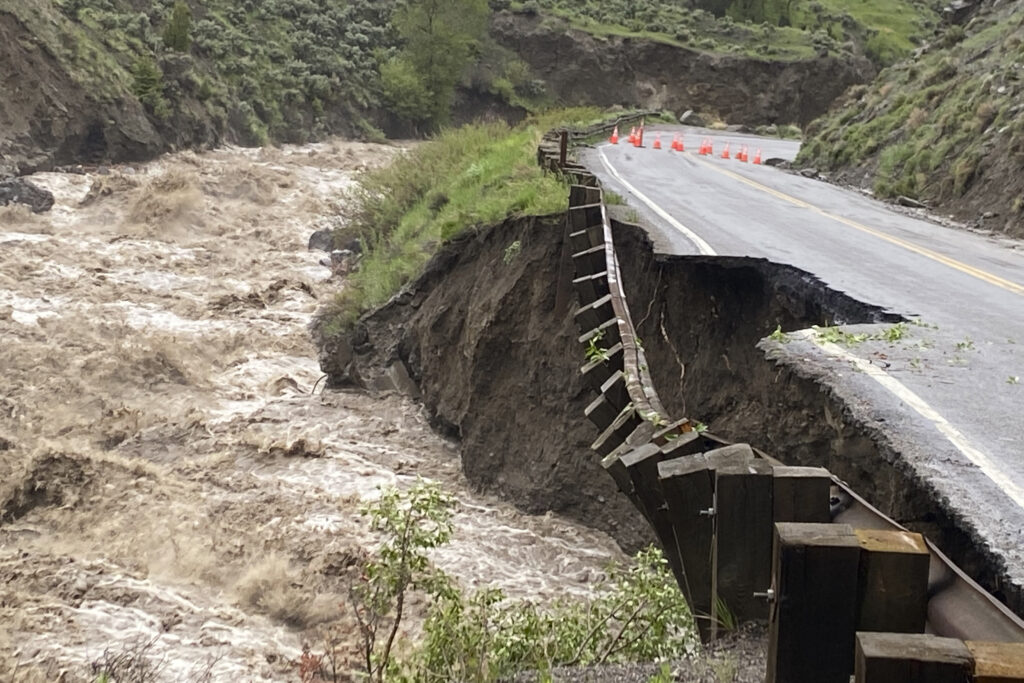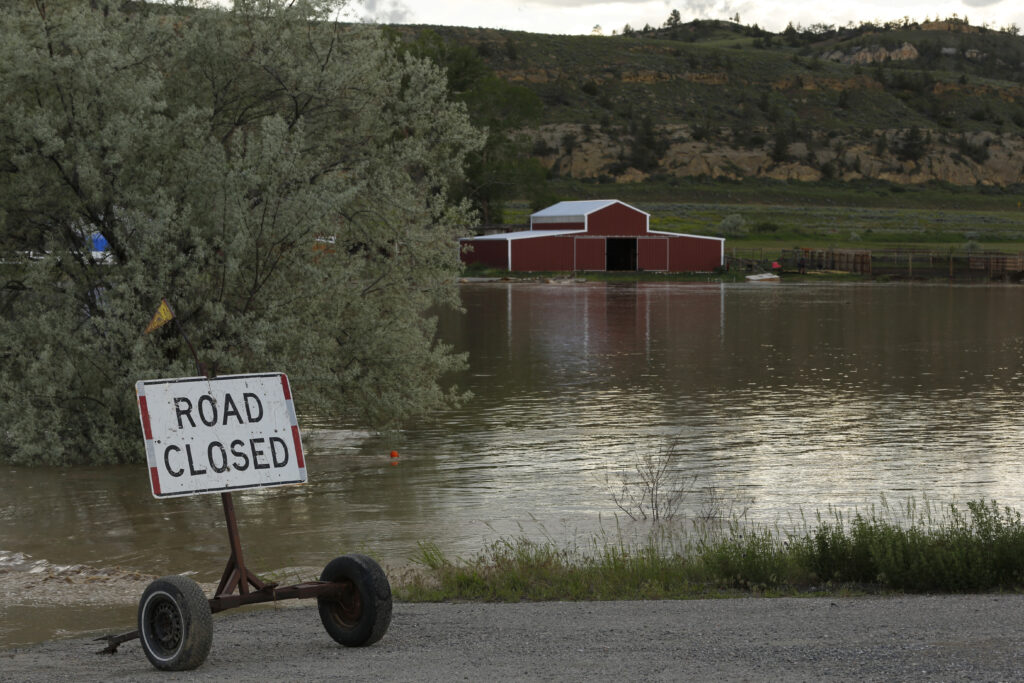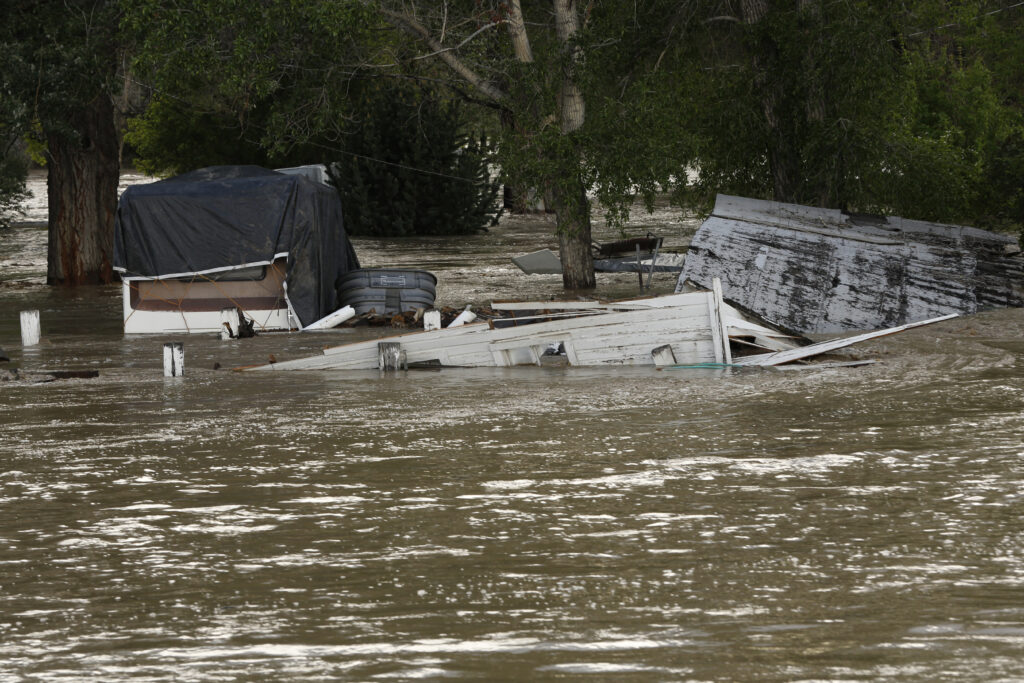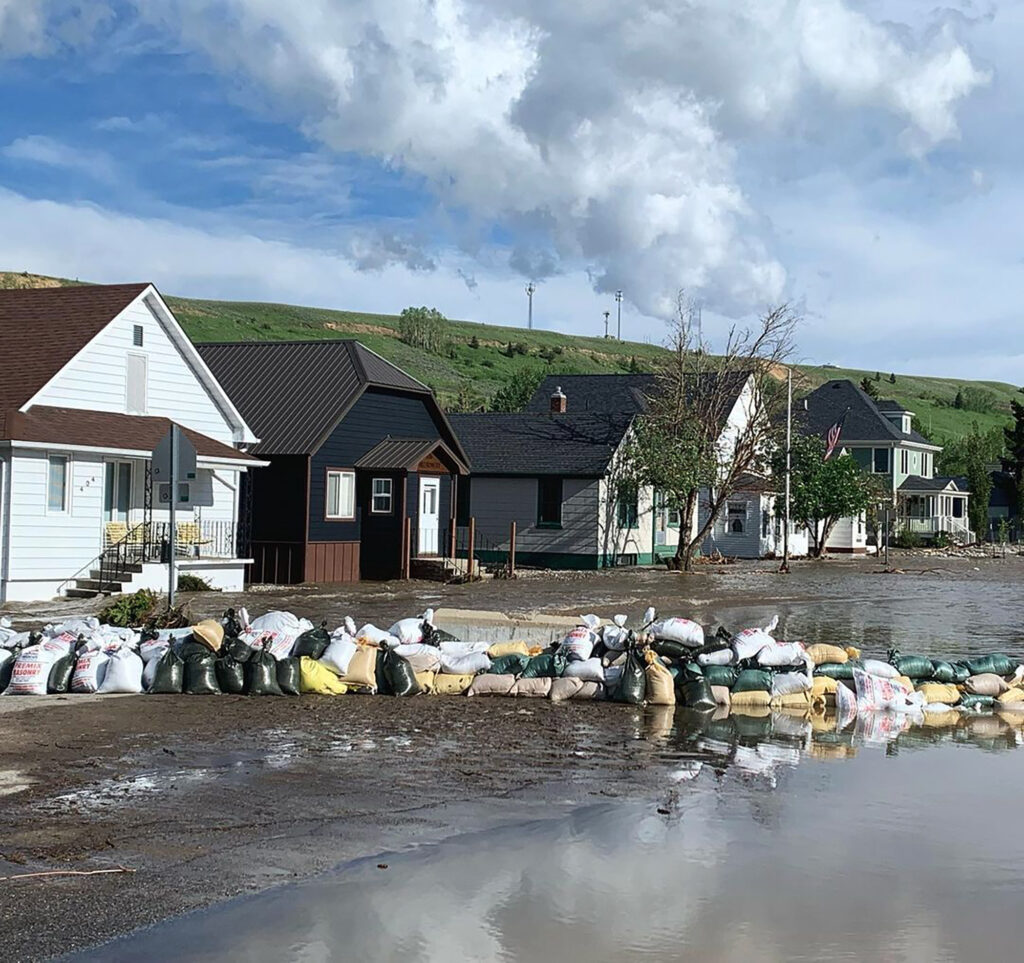Heavy rains continue in Montana and Wyoming, flooding much of Yellowstone National Park. It shut down after the Yellowstone River crested higher than ever recorded. The Associated Press has the story:
Waters start to recede Tuesday in flooded Yellowstone
HELENA, Mont. (AP) — Floodwaters higher than any in more than a century tore through Yellowstone National Park and surrounding areas, sweeping away houses, washing out bridges and roads, stranding tourists and residents, and prompting frantic helicopter and raft rescues.
The flooding across parts of southern Montana and northern Wyoming from days of rain and a rapidly melting snowpack indefinitely closed one of the nation’s most iconic parks just as a summer tourist season that draws millions of visitors was ramping up.
North of the park, hundreds of people remained isolated Tuesday after the Yellowstone River crested higher than ever recorded in a chocolate brown torrent that washed away anything in its path. While no one has been reported killed or injured, waters were only starting to recede Tuesday and the full extent of the destruction wasn’t yet known.

“It is just the scariest river ever,” Kate Gomez of Santa Fe, New Mexico, said Tuesday. “Anything that falls into that river is gone. The swells are huge and it’s just mud and silt.”
Gomez and her husband were among hundreds of tourists stuck in Gardiner, Montana, a town of about 800 residents at the north entrance to the park. The town was cut off for more than a day until Tuesday afternoon, when crews managed to get part of a washed away two-lane road reopened. Officials warned that driving conditions were still dangerous.
While the flooding can’t directly be attributed to climate change, it came as the Midwest and East Coast sizzle from a heat wave and other parts of the West burn from an early wildfire season amid a persistent drought that has increased the frequency and intensity of fires that are having broader impacts. Smoke from a fire in the mountains of Flagstaff, Arizona, could be seen in Colorado.
Rick Thoman, a climate specialist at the University of Alaska Fairbanks, said a warming environment makes extreme weather events more likely “than they would have been without the warming that human activity has caused.”

“Will Yellowstone have a repeat of this in five or even 50 years? Maybe not, but somewhere will have something equivalent or even more extreme,” he said. “It was just this time last year we were talking about the heat dome over the Pacific Northwest. These extreme heat events are becoming more common. It’s not the same place every year. It isn’t going to be the same place every year.”
The towns of Cooke City and Silvergate, just east of the park, were also isolated by floodwaters.
Heavy rain on top of melting mountain snow pushed the Yellowstone, Stillwater and Clarks Fork rivers to record levels Monday, according to the National Weather Service.
Officials in Yellowstone and in several southern Montana counties were assessing damage from the storms, which also triggered mudslides and rockslides. Montana Gov. Greg Gianforte declared a statewide disaster.

In Livingston, low-lying neighborhoods were evacuated and the city’s hospital was evacuated as a precaution after its driveway flooded.
It was unclear how many visitors to the region remained stranded or have been forced to leave Yellowstone, or how many people who live outside the park were rescued and evacuated.
Some of the worst damage happened in the northern part of the park and Yellowstone’s gateway communities in southern Montana. National Park Service photos of northern Yellowstone showed a mudslide, washed out bridges and roads undercut by churning floodwaters of the Gardner and Lamar rivers.
Officials in Park County, which includes Gardiner and Cooke City, said extensive flooding throughout the county had made drinking water unsafe in many areas.
The Montana National Guard said Monday it sent two helicopters to southern Montana to help with the evacuations.
In south-central Montana, flooding on the Stillwater River stranded 68 people at a campground. Stillwater County Emergency Services agencies and crews with the Stillwater Mine rescued people Monday from the Woodbine Campground by raft. Some roads in the area are closed because of flooding and residents have been evacuated.
“We will be assessing the loss of homes and structures when the waters recede,” the sheriff’s office said in a statement.
Cory Mottice, a meteorologist with the National Weather Service in Billings, Montana, said rain is not in the immediate forecast, and cooler temperatures will lessen the snowmelt in coming days.
“This is flooding that we’ve just never seen in our lifetimes before,” Mottice said.
The Yellowstone River at Corwin Springs crested at 13.88 feet (4.2 meters) Monday, higher than the previous record of 11.5 feet (3.5 meters) set in 1918, according the the National Weather Service.
At a cabin in Gardiner, Parker Manning got an up-close view of the water rising and the river bank sloughing off in the raging Yellowstone River floodwaters just outside his door.
“We started seeing entire trees floating down the river, debris,” Manning, who is from Terra Haute, Indiana, told The Associated Press. “Saw one crazy single kayaker coming down through, which was kind of insane.”
On Monday evening, Manning watched as the rushing waters undercut the opposite riverbank, causing a house to fall into the river and float away mostly intact.
Floodwaters inundated a street in Red Lodge, a Montana town of 2,100 that’s a popular jumping-off point for a scenic, winding route into the Yellowstone high country. Twenty-five miles (40 kilometers) to the northeast, in Joliet, Kristan Apodaca wiped away tears as she stood across the street from a washed-out bridge, The Billings Gazette reported.
The log cabin that belonged to her grandmother, who died in March, flooded, as did the park where Apodaca’s husband proposed.
“I am sixth-generation. This is our home,” she said. “That bridge I literally drove yesterday. My mom drove it at 3 a.m. before it was washed out.”
On Monday, Yellowstone officials evacuated the northern part of the park, where roads may remain impassable for a substantial length of time, park Superintendent Cam Sholly said in a statement.
But the flooding affected the rest of the park, too, with park officials warning of yet higher flooding and potential problems with water supplies and wastewater systems at developed areas.
The rains hit just as area hotels have filled up in recent weeks with summer tourists. More than 4 million visitors were tallied by the park last year. The wave of tourists doesn’t abate until fall and June is typically one of Yellowstone’s busiest months.
Yellowstone got 2.5 inches (6 centimeters) of rain Saturday, Sunday and into Monday. The Beartooth Mountains northeast of Yellowstone got as much as 4 inches (10 centimeters), according to the National Weather Service.
___
By AMY BETH HANSON and MATTHEW BROWN
Brown reported from Billings, Montana. Associated Press writers Becky Bohrer in Juneau, Alaska, Lindsay Whitehurst in Salt Lake City, Brian Melley in Los Angeles, Thomas Peipert in Denver, Mead Gruver in Fort Collins, Colorado, and Lisa Baumann in Bellingham, Washington, contributed to this report.







